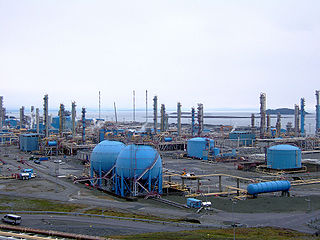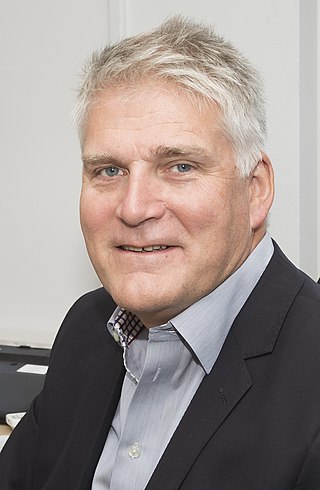Related Research Articles

Snøhvit(English: Snow White) is the name of a natural gas field in the Norwegian Sea, situated 140 kilometres (87 mi) northwest of Hammerfest, Norway. The northern part of the Norwegian Sea is often described as the Barents Sea by offshore petroleum companies. Snøhvit is also the name of a development of Snøhvit and the two neighbouring natural gas fields Albatross and Askeladden. Estimated recoverable reserves are 193 billion cubic metres of natural gas, 113 million barrels of condensate, and 5.1 million tonnes of natural gas liquids (NGL). The development comprises 21 wells. The Snøhvit development is operated by Equinor on behalf of six gas companies owning licenses:

Coal pollution mitigation, sometimes labeled as clean coal, is a series of systems and technologies that seek to mitigate health and environmental impact of burning coal for energy. Burning coal releases harmful substances that contribute to air pollution, acid rain, and greenhouse gas emissions. Mitigation includes precombustion approaches, such as cleaning coal, and post combustion approaches, include flue-gas desulfurization, selective catalytic reduction, electrostatic precipitators, and fly ash reduction. These measures aim to reduce coal's impact on human health and the environment.

Carbon capture and storage (CCS) is a process by which carbon dioxide (CO2) from industrial installations is separated before it is released into the atmosphere, then transported to a long-term storage location. The CO2 is captured from a large point source, such as a natural gas processing plant and is typically stored in a deep geological formation. Around 80% of the CO2 captured annually is used for enhanced oil recovery (EOR), a process by which CO2 is injected into partially-depleted oil reservoirs in order to extract more oil and then is largely left underground. Since EOR utilizes the CO2 in addition to storing it, CCS is also known as carbon capture, utilization, and storage (CCUS).
Enhanced oil recovery, also called tertiary recovery, is the extraction of crude oil from an oil field that cannot be extracted otherwise. Whereas primary and secondary recovery techniques rely on the pressure differential between the surface and the underground well, enhanced oil recovery functions by altering the physical or chemical properties of the oil itself in order to make it easier to extract. When EOR is used, 30% to 60% or more of a reservoir's oil can be extracted, compared to 20% to 40% using only primary and secondary recovery.
An integrated gasification combined cycle (IGCC) is a technology using a high pressure gasifier to turn coal and other carbon based fuels into pressurized gas—synthesis gas (syngas). It can then remove impurities from the syngas prior to the electricity generation cycle. Some of these pollutants, such as sulfur, can be turned into re-usable byproducts through the Claus process. This results in lower emissions of sulfur dioxide, particulates, mercury, and in some cases carbon dioxide. With additional process equipment, a water-gas shift reaction can increase gasification efficiency and reduce carbon monoxide emissions by converting it to carbon dioxide. The resulting carbon dioxide from the shift reaction can be separated, compressed, and stored through sequestration. Excess heat from the primary combustion and syngas fired generation is then passed to a steam cycle, similar to a combined cycle gas turbine. This process results in improved thermodynamic efficiency, compared to conventional pulverized coal combustion.

The Virgin Earth Challenge was a competition offering a $25 million prize for whoever could demonstrate a commercially viable design which results in the permanent removal of greenhouse gases out of the Earth's atmosphere to contribute materially in global warming avoidance. The prize was conceived by Richard Branson, and was announced in London on 9 February 2007 by Branson and former US Vice President Al Gore.

Kårstø is an industrial facility located near the village of Susort, along the Boknafjorden, in the municipality of Tysvær in Rogaland county, Norway. The site features a number of natural gas processing plants that refine natural gas and condensate from the fields in the northern parts of the North Sea, including the Åsgard, Mikkel, and Sleipner gas fields. The Kårstø processing complex is Europe's biggest export port for natural gas liquids (NGL) and the third largest in the world. The industrial site is also the location for the now-closed Kårstø Power Station.

Mongstad Power Station is a natural gas-fired combined power plant and heating plant located at the industrial site of Mongstad in Norway.
Carbon capture and storage (CCS) is a technology that can capture carbon dioxide CO2 emissions produced from fossil fuels in electricity, industrial processes which prevents CO2 from entering the atmosphere. Carbon capture and storage is also used to sequester CO2 filtered out of natural gas from certain natural gas fields. While typically the CO2 has no value after being stored, Enhanced Oil Recovery uses CO2 to increase yield from declining oil fields.
The milestones for carbon capture and storage show the lack of commercial scale development and implementation of CCS over the years since the first carbon tax was imposed.

Carbon dioxide removal (CDR) is a process in which carbon dioxide is removed from the atmosphere by deliberate human activities and durably stored in geological, terrestrial, or ocean reservoirs, or in products. This process is also known as carbon removal, greenhouse gas removal or negative emissions. CDR is more and more often integrated into climate policy, as an element of climate change mitigation strategies. Achieving net zero emissions will require first and foremost deep and sustained cuts in emissions, and then—in addition—the use of CDR. In the future, CDR may be able to counterbalance emissions that are technically difficult to eliminate, such as some agricultural and industrial emissions.

Bioenergy with carbon capture and storage (BECCS) is the process of extracting bioenergy from biomass and capturing and storing the carbon dioxide (CO2) that is produced.
Eston Grange Power Station was a proposed power station to be situated near to Eston in Redcar and Cleveland. If built, it would have been the UK's first pre-combustion carbon capture and storage (CCS) plant. The station could have generated up to 850 megawatts of electricity, enough to supply around a million people with electricity. The station would use standard oil refinery technology to turn gasified coal into hydrogen and carbon dioxide.
The Korea Carbon Capture & Sequestration R&D Center (KCRC) is an institution in Daejeon, South Korea, specialized in Carbon Capture & Sequestration (CCS) R&D. The Korean government has selected CCS technology as part of core technologies for green growth, and has established the National Comprehensive Plan for CCS to commercialize and ensure the international competitiveness of CCS technology by 2020. As part of the plan, the Ministry of Science, ICT and future Planning (MSIP) has developed the ‘Korea CCS 2020 Project' to secure the best original technology of CCS and established KCRC on December 22, 2011.
The White Rose Carbon Capture and Storage project was a proposed oxy-fuel coal-fired power plant near the Drax power station in North Yorkshire, United Kingdom. It was proposed in 2012 by Capture Power Limited (in partnership with National Grid). This project would have been the first coal-fired power plant to demonstrate the use of oxy-fuel technology for low-carbon electricity at a competitive cost. The proposed 426 MW plant was expected to send 2 Mt CO2/year to an offshore saline aquifer, achieving 90% capture. The Development Consent Order application submitted to the Department of Energy and Climate Change, now Department for Business, Energy and Industrial Strategy, was rejected in April 2016. The rejection was on the basis that the project had no route to funding, following the UK government cancelling a carbon capture and storage competition in November 2015.

Nils Anders Røkke is a Norwegian scientist and business leader. He is the Executive Vice President Sustainability SINTEF. He is as of May 2017 the Chairman of The European Energy Research Alliance. EERA is the public research pillar of the EU Strategic Energy Technology Plan(SET-Plan). The SET-Plan aims at accelerating the development and market uptake of key low carbon technologies. EERA brings together more than 170 research centres and universities, working together on 17 joint research programmes, they build on national research initiatives.

Direct air capture (DAC) is the use of chemical or physical processes to extract carbon dioxide directly from the ambient air. If the extracted CO2 is then sequestered in safe long-term storage (called direct air carbon capture and sequestration, the overall process will achieve carbon dioxide removal and be a "negative emissions technology".

Carbon storage in the North Sea includes programmes being run by several Northern European countries to capture carbon, and store it under the North Sea in either old oil and gas workings, or within saline aquifers. Whilst there have been some moves to international co-operation, most of the Carbon Capture and Storage (CCS) programmes are governed by the laws of the country that is running them. Because the governments have pledged net zero carbon emissions by 2050, they have to find ways to deal with any remaining CO2 produced, such as by heavy industry. Around 90% of the identified storage geologies for carbon dioxide in Europe are shared between Norway and the United Kingdom; all of the designated sites for storage are located in the North Sea.
The Carbon Connect Delta Program is a proposed carbon sequestration program to aid Belgium and the Netherlands in achieving carbon neutrality by 2030. It aims to capture, transport, and store 6.5 million tones of CO2 by 2030 using carbon capture and storage (CCS) in the transboundary area of the North Sea Port area of the Scheldt-Delta region connecting Belgium and the Netherlands.
References
- ↑ "Developing Longship - Key lessons learned". Fullskala. Retrieved 2024-11-14.